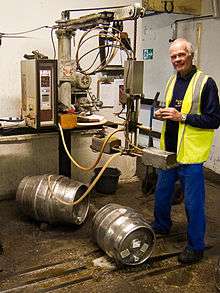Isinglass

Isinglass (/ˈaɪzɪŋɡlæs/ or /ˈaɪzɪŋɡlɑːs/) is a substance obtained from the dried swim bladders of fish. It is a form of collagen used mainly for the clarification or fining of some beer and wine. It can also be cooked into a paste for specialised gluing purposes.
Its origin is from the obsolete Dutch huizenblaas - huizen is a kind of sturgeon, and blaas is a bladder. [1] Isinglass is no longer sourced from sturgeon. The fish maws used to manufacture isinglass are a by product of sustainable local fishing economies and the use of isinglass as a beer clarifier assists in supporting these rural economies.
Although originally made exclusively from sturgeon, especially beluga, in 1795 an invention by William Murdoch facilitated a cheap substitute using cod. This was extensively used in Britain in place of Russian isinglass. The bladders, once removed from the fish, processed, and dried, are formed into various shapes for use.
Foods and drinks

Before the inexpensive production of gelatin and other competing products, isinglass was used in confectionery and desserts such as fruit jelly and blancmange.
Isinglass finings is widely used as a processing aid in the British brewing industry to accelerate the fining, or clarification, of beer. It is used particularly in the production of cask-conditioned beers, although a few cask ales are available which are not fined using isinglass. The finings flocculate the live yeast in the beer into a jelly-like mass, which settles to the bottom of the cask. Left undisturbed, beer will clear naturally; the use of isinglass finings accelerates the process. Isinglass is sometimes used with an auxiliary fining, which further accelerates the process of sedimentation.
Non-cask beers that are destined for kegs, cans, or bottles are often pasteurized and filtered. The yeast in these beers tends to settle to the bottom of the storage tank naturally, so the sediment from these beers can often be filtered without using isinglass. However, some breweries still use isinglass finings for non-cask beers, especially when attempting to repair bad batches.
Although very little isinglass remains in the beer when it is drunk, many vegetarians[2] consider beers that are processed with these finings (such as most cask-conditioned ales in the UK[3]) to be unsuitable for vegetarian diets (although acceptable for pescetarians).[4] A beer-fining agent that is suitable for vegetarians is Irish moss, a type of red algae also known as carrageenan.[5] However, carrageenan-based products (used in both the boiling process and after fermentation) primarily reduce hazes caused by proteins, but isinglass is used at the end of the brewing process, after fermentation, to remove yeast. Since the two fining agents act differently (on different haze-forming particles), they are not interchangeable, and some beers use both.
Isinglass finings are also used in the production of kosher wines, although for reasons of kashrut, they are not derived from the beluga sturgeon, as this fish is not kosher.[6] Whether the use of a nonkosher isinglass renders a beverage nonkosher is a matter of debate in Jewish law. Rabbi Yehezkel Landau, in Noda B'Yehuda, first edition, Yore Deah 26, for example, permits such beverages.[6] This is the position followed by many kashrut-observant Jews today.
Egg preservative
Isinglass was used as a preservative in Britain in the 1940s before and during the second world war. Isinglass from tins was dissolved into water, typically in a bucket. The resulting solution acted as an effective preservative for fresh eggs which were submerged in it.[7]
Parchment conservation
Isinglass is also used to help repair parchment. Pieces of the best Russian isinglass are soaked overnight to soften and swell the dried material. Next, it is cooked slowly in a double boiler at 45°C while being stirred. A small amount of gum tragacanth dissolved in water is added to the strained isinglass solution to act as an emulsifier.
When repairing paint that is flaking from parchment, isinglass can be applied directly to an area which has been soaked with a small amount of ethanol. It is typically applied as a very tiny drop that is then guided, with the help of a binocular microscope, under the edges of flaking paint.
It can also be used to coat tissue or goldbeater's skin. Here, isinglass is similar to parchment size and other forms of gelatin, but it is unique in that as a dried film the adhesive can be reactivated with moisture. For this use, the isinglass is cooked with a few drops of glycerin or honey. This adhesive is advantageous in situations where minimal use of water is desired for the parchment as the isinglass can be reactivated with an ethanol-water mixture. It also has a greater adhesive strength than many other adhesives used for parchment repair. [8]
See also
- Thin transparent sheets of mica called "isinglass"
- Sodium silicate used in food preservation colloquially called "isinglass"
References
- ↑ (Chambers 20th century dictionary)
- ↑ "Is your booze vegan?". barnivore.com. Retrieved 21 December 2012.
- ↑ "Gingering up the real ale range". The Independent. 23 July 1994. Retrieved 21 December 2012.
- ↑ "Dyed Smarties make vegetarians see red". The Age. 29 October 2004. Retrieved 21 December 2012.
- ↑ Kate Jackson, Sara Wallis (21 May 2007). "Guinness - 'May Contain Fish'". Daily Mirror. Retrieved 21 December 2012.
- 1 2 נודע ביהודה מהדורה קמא, יורה דעה, כ"ו (in Hebrew). The Society for Preservation of Hebrew Books. Retrieved 21 December 2012.
- ↑ "Preserving Eggs". CooksInfo.com. Retrieved 25 May 2016.
- ↑ (Quandt, 1996)
Further reading
- Davidson, Alan (1999). "Isinglass". Oxford Companion to Food. p. 407. ISBN 0-19-211579-0.
- Quandt, Abigail B. (1996). "Recent Developments in the Conservation of Parchment Manuscripts". The American Institute for Conservation, The Book and Paper Group Annual.
- Woods, Chris (1995). "Conservation Treatments for Parchment Documents", Journal of the Society of Archivists, Vol. 16, Issue 2, pp. 221–239.